What is a double edge safety razor – The double edge safety razor features a handle, typically knurled, along with a head that has a protective safety bar that helps to reduce nicks and cuts while shaving.
Originally introduced in 1903 by King Camp Gillette (US patent 775,134) and was widely adopted by men when it became part of the standard issue field kit for the U.S. Army during World War I (source).
Over 100 years later, the safety razor is still used by many men due to the key benefits it can deliver – namely, the low lifetime cost of ownership, decreased risk of razor burn and bumps, along with its relatively good shave performance.
Note: Common cartridge razors such as those from Schick, Gillette, etc. are technically classified as safety razors as they employ similar mechanisms to ensure user safety. However, for the scope of this article, we will only be discussing the double edge safety razor as it is what’s most often associated with the term safety razor (and the term we are using henceforth).
Here’s more about what a safety razor is (and what it isn’t):
Video Summary
If you prefer a video overview of a safety razor – check out the video below were we go over much of the same information covered in this post:
Where Does the ‘Safety’ in Safety Razor Come From?
One of the common misconceptions about this razor is in the name itself – safety razor. Despite the name, when used improperly, this razor is dangerous. To understand how it got its name, you have to look at the razor market when it was introduced.
Prior to the safety razor, men used a straight razor (also called a cut-throat razor). The straight razor only contained a single cutting blade and had no safety features.
When introduced, the safety razor had a safety bar that made using it significantly safer:
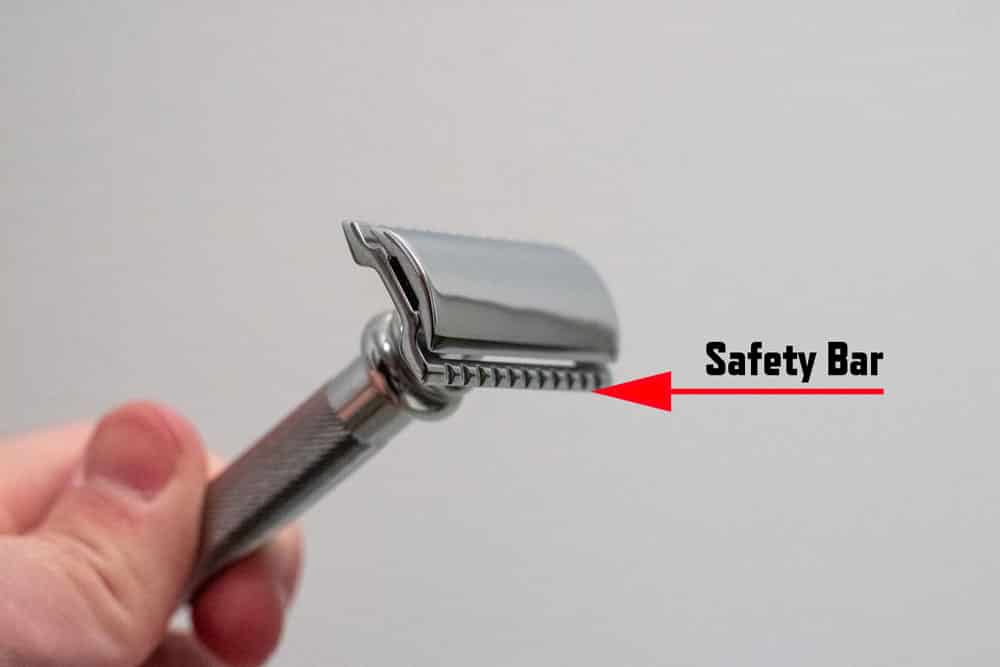
Why was this a big deal?
Well, the safety bar helps to tighten and flatten the skin in order to get a cleaner cut on the hair with a reduced chance of hurting yourself when shaving. Here’s how it looks as demonstrated on an arm (no blade was loaded in this demonstration):
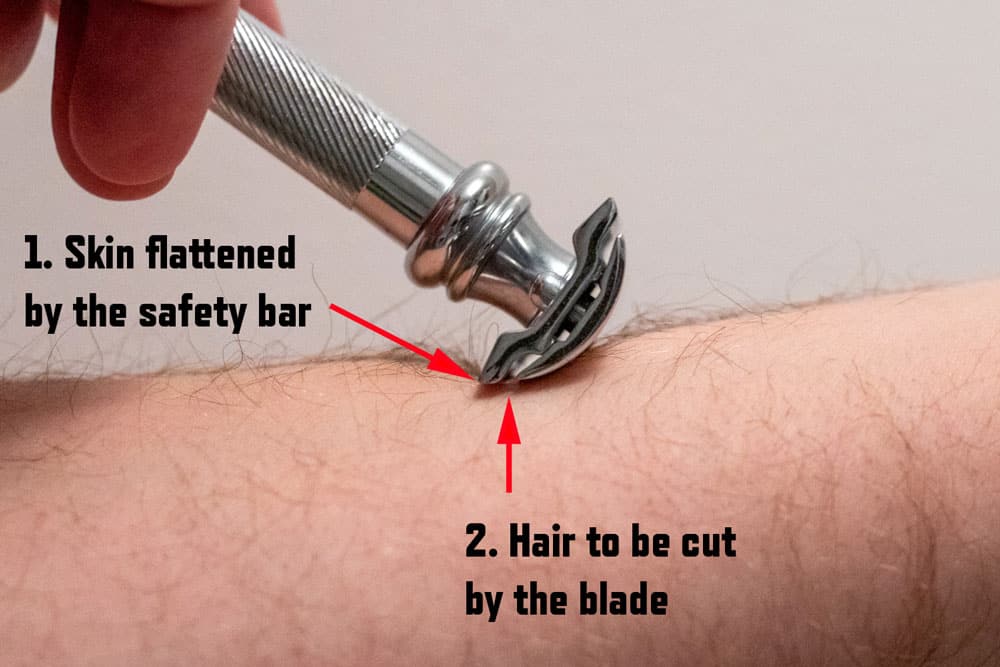
When compared to a straight razor, it is easy to see how advanced this razor truly was.
Additionally, this design allowed for a quicker shave in the morning.
What are the Parts of the Safety Razor?
Here’s a look at all the parts that make up a two and three-piece safety razor:
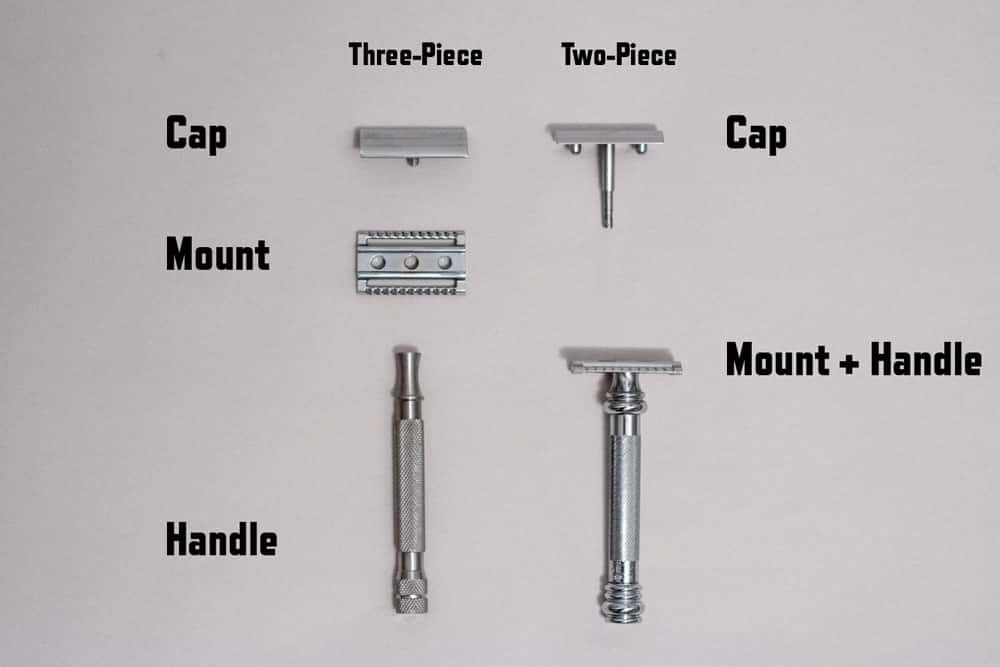
Cap (Razor Head)
The cap of the safety razor provides a setting for the razor blade to rest upon. The cap has a threaded post that screws into the handle.
Mount
The mount of the safety razor can be fixed as seen with a two-piece safety razor, or loose as demonstrated by the three-piece safety razor. Neither the two nor three-piece razor offers a significant advantage over the other. Some men may enjoy the three-piece razor a slight bit more as you can take it fully apart to clean.
Comb (Safety Bar) Type – Closed vs. Open vs. Slant Safety Razors
The comb that is featured on the edge of the mount can vary significantly across brands and results in different shaving experiences.
Here are the most common combs that can be found on safety razors:
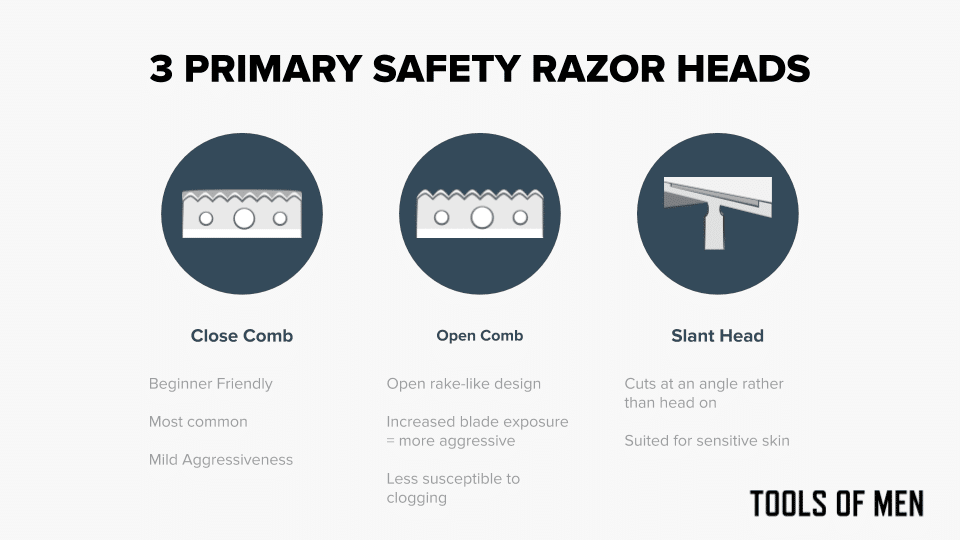
Closed Comb (Safety Bar)
The closed comb is the most popular mount edge found on safety razors. It plays an important role in the shaving process as it helps to tighten the skin prior to it being cut. A closed comb provides a mild shave and is best suited for beginners.
The safety bar on the closed comb extends the full width of the head and provides an even distribution of pressure. A closed comb is what was also pictured earlier in the comparison between the two and three-piece razor.
Open Comb
Open combs increase blade exposure by removing part of the safety bar and instead relying on a cutout rake-like or teeth design. An open comb safety razor provides an aggressive cut to the hair.
Open combs are best suited for men who are familiar with safety razors. These razors can also be used by men who shave infrequently as they can cut longer facial hair with a reduced risk of clogging.
Slant Bar
Found in only select safety razors, a slant bar razor cuts facial hair in a completely different manner. Rather than cutting the hair straight on, a slant bar tilts the razor so that it cuts at an angle – leading many men to compare this comb type to a scythe.
Slant bars are recommended for men experienced with a safety razor and those with sensitive skin as the unique cutting motion reduces tugging and pulling on the hair follicle root.
Cap Attached to the Handle
With the blade set between both the cap and mount, once screwed together, you will see that the blade is now set and ready to cut:
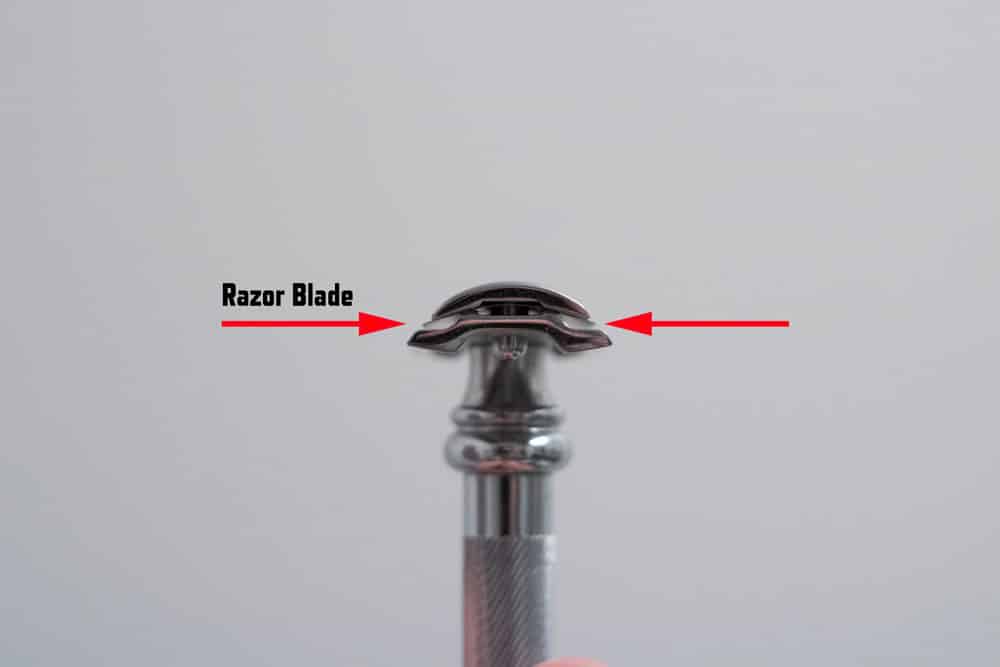
As you can see from above, the razor blade edge pokes out of both sides and can be used either way to cut hair. This is also how this razor gets the name – double edge safety razor.
Side note about adjustable safety razors: Adjustable safety razors are a unique system where you can turn the handle and increase and decrease the blade gap (the area between the blade and the safety bar). This allows you to fine-tune the shave to be either milder or more aggressive. For reference, the razor pictured above has a fixed blade gap.
Fixed Head Movement
Unlike cartridge razors that have a pivoting head which allows for the razor blades to remain in contact with your skin while shaving, safety razor heads do not move or pivot.
This means that you must always hold the razor blade at the optimal cutting angle between 30 and 45 degrees. Going too narrow or too open with the razor can result in irritation or poor results.
Handle
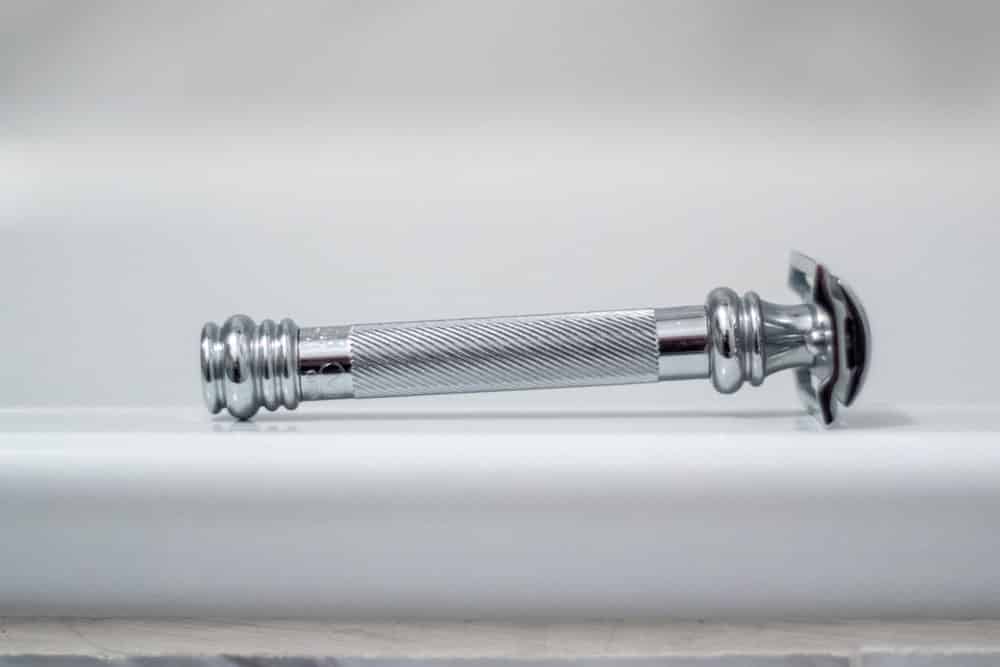
The handle of the safety razor can vary in length, weight, and grip. Here’s why they matter:
Length
Traditionally, safety razors have short handles that are around 4″ in total length (give or take .25″):
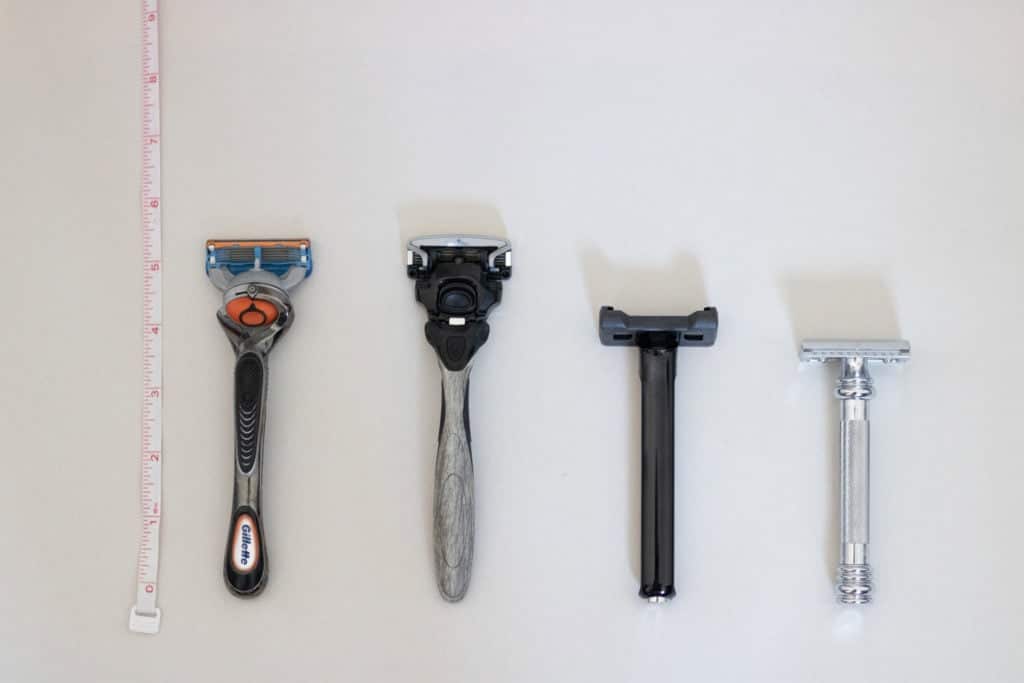
Shorter handles offer a unique advantage in that they allow for a better grip and control. This is especially important should your hands be coated with shaving cream.
Longer handles are only recommended for men with larger than average hands.
Weight
Made from stainless steel or a zinc alloy, safety razors are significantly heavier when compared to other popular razor systems:

As you can see, the safety razor weighs more than twice than that of a cartridge razor at 110g.
Grip
Grip varies across safety razors. However, the most common one you will find is a knurled. This unique manufacturing process makes an etching on the handle which provides you with an increased grip.
The other common finish for the grip will be a smooth handle.
What Razor Blades are Compatible with a Safety Razor?
One of the major reasons that men are rediscovering this unique shaving tool is due to the blades…
…unlike modern cartridge razors that have different proprietary fittings across brands:
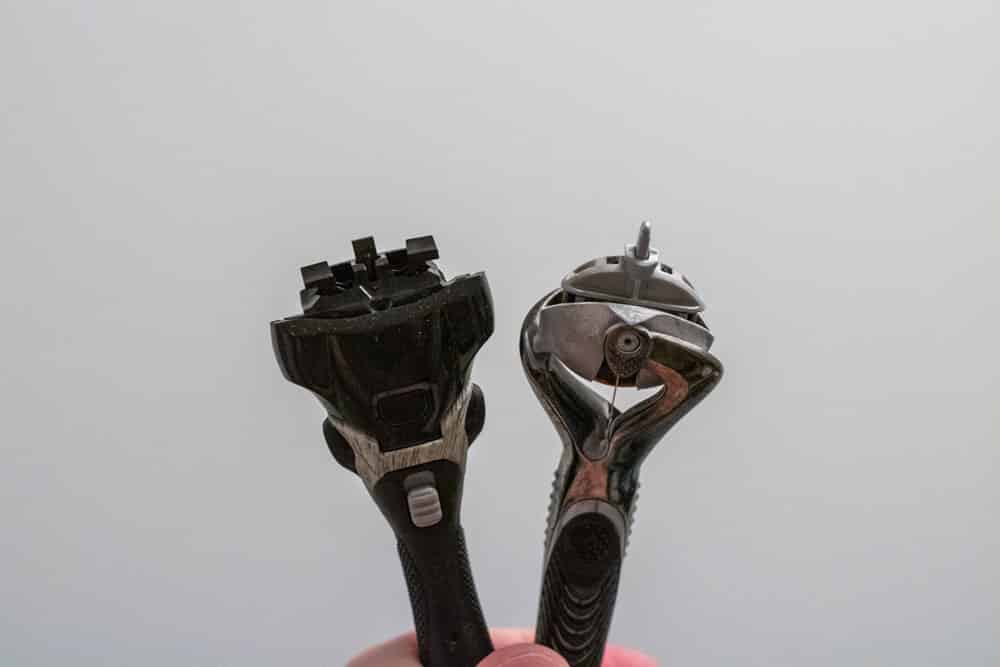
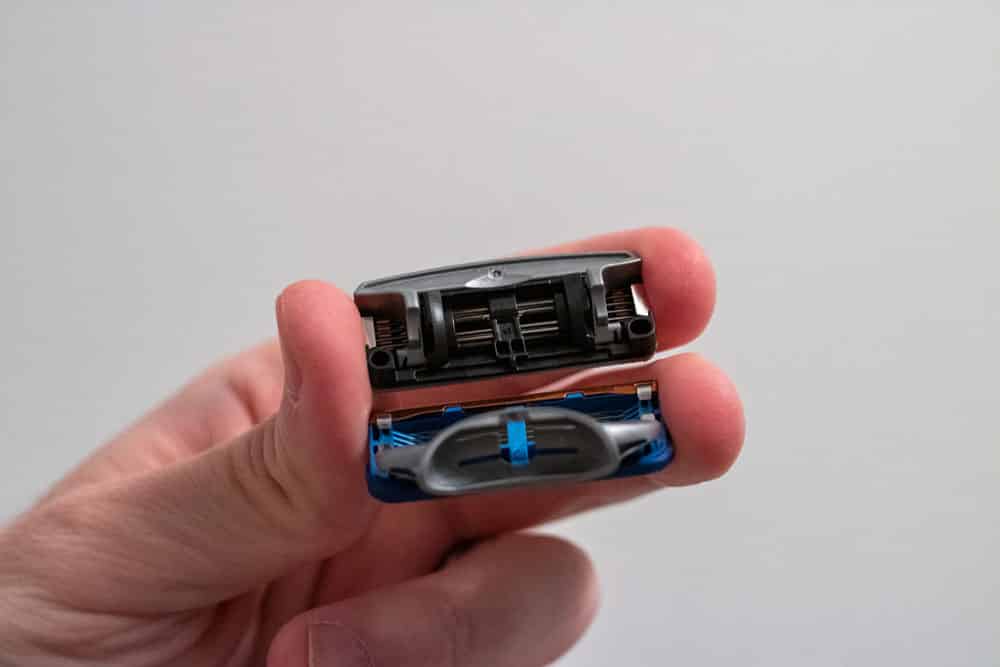
Pictured above are Schick and Gillette cartridge razors to demonstrate how their blades use different proprietary systems that cannot be swapped between brands.
Safety razor blades offer a universal fitting as demonstrated here across many different brands, including Wilkinson Sword, Gillette, and Feather:
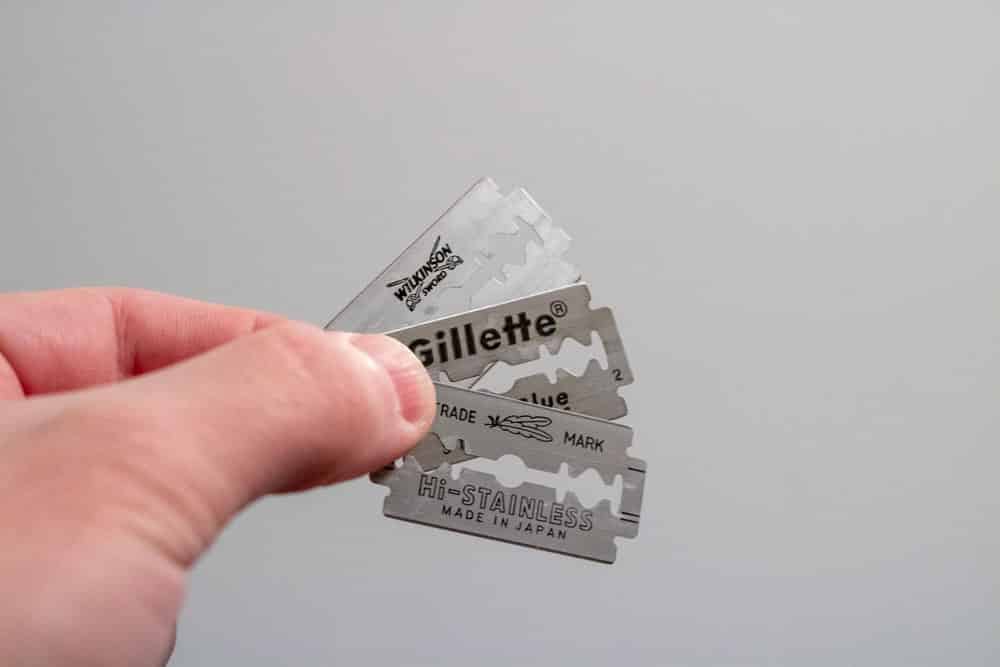
This allows any of the brands to slide easily onto the head of any safety razor:
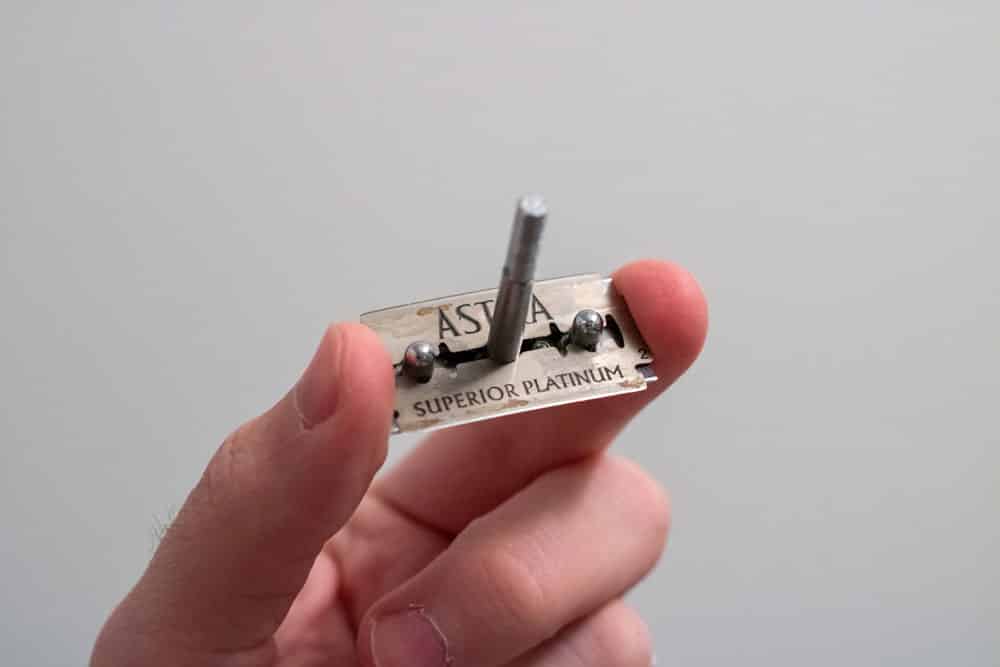
Note: Above is a razor blade that sits on a three-pronged fitting. A butterfly razor uses one long horizontal bar to hold the razor blade, which is still compatible thanks to the universal design.
What does all this mean for you?
This not only allows for a significantly lower price per blade due to increased competition among brands, but you also have the ability to try out several different razor blade brands until you find the right one that works with your unique facial hair and skin type.
Unlike cartridge razors where you may want to extend the life of the blade long past the recommended use, thanks to the low cost of safety razor blades, you can simply swap them out frequently.
Is Shaving with a Safety Razor Better?
Whether it’s better or not to shave with a safety razor is highly subjective and largely dependent on your personal habits, facial hair type, and your shaving requirements.
Men who have made the change to a safety razor have often found the transition quite difficult at first – particularly when it comes to the learning curve.
If you are coming from a background using a cartridge or disposable razor, you should expect that you will need to re-learn how to shave due to the non-pivoting movement of the head.
Additionally, unlike modern razor systems that can shave any part of your body with relative ease, safety razors aren’t recommended for manscaping below the belt. However, you may be able to use a safety razor on relatively flatter surfaces without much of a problem – particularly the chest, arms, or legs (some women use safety razors for this very reason).
What are Some Downsides to Using a Safety Razor?
The safety razor does have many significant downsides that aren’t readily apparent. Here are a few notable limitations when using this razor:
- Not TSA Compliant: Post-9/11 safety razor blades are banned from carry-on luggage – however, you can bring your safety razor onboard (source). The problem with this is that safety razor blades may be hard to find if you plan on purchasing them at your destination. Some local drugstores may carry them. If you want to bring your safety razor blades with you, they must be in your checked luggage.
- Learning to Shave (again): As we touched on previously, the learning curve for using a safety razor is steep. Expect a few nicks and cuts along the way. If dedicated to the tool, you can expect your first good shave after a couple of weeks of training.
- They Take A Little More Time: Expect your shave to take a few more minutes to accomplish than it currently does. If you are always in a rush during the morning – this may be a potential problem for you.
- Difference Between Safety Razor Brands: When deciding on a safety razor, you can quickly get analysis paralysis. Safety razors differ significantly from one another in terms of weight, length, and cutting head style and can result in a different shaving experience.
- Lack of A Pivot Head: Arguably the biggest advantage to the disposable and cartridge razor is the pivot head. With a safety razor, you must adjust it to the proper angle – always. No distracted shaving here.
- Quality Concerns: Despite being made from metal, some safety razors are susceptible to chipping when dropped on hard floors or may corrode over time.
What About the Upsides to Using a Safety Razor?
Despite their age, safety razors still hold many advantages over other shave systems:
- Lifetime Cost of Ownership Remains Low: While a typical safety razor handle will cost higher when compared to a cartridge or disposable razor, the low cost of replacement blades at just $0.10 to $0.25 cents each makes this a budget-friendly razor.
- Less Irritation: When using just a single blade rather than 3, 4, or 5 of them stacked like a cartridge razor, there is less contact of the razor blade with your skin. This inevitably reduces your chances of irritation, razor bumps (ingrown hairs), and razor burn. Men who are susceptible to such side effects enjoy the relief that the safety razor can provide.
- Build Quality Is Better: With a solid metal design, safety razors are durable and can be cleaned with an antiseptic regularly. There are no small plastic moving parts here.
- Moderate to Close Shave: With the reliance on only one blade, you can decide whether you want to make only one or several passes with the razor. More passes can give you that often-desired smooth result.
Note:
Safety razors do not experience hysteresis like cartridge razors. Meaning that they do not lift and cut the hair as there is only a single cutting edge. This can be both an advantage and a disadvantage, depending on your shaving needs.
Do You Need Different Shaving Supplies When Using a Safety Razor?
In short, no. Safety razors can work with your existing shave cream and there is no reason that you must go out and purchase a cast of new shaving supplies.
However, we would be doing a disservice if we didn’t at least touch on the fact that quality shave creams, shaving oils, soaps, and brushes can make a measurable impact on your overall shave comfort. This is why you often see men who use safety razors also use premium products as they can make the experience a whole lot better.
Who Makes Safety Razors Today?
Some of the most respected safety razors brands include the following:
| Brand | Location | Founded |
|---|---|---|
| DOVO Solingen / Merkur | Solingen, Germany | 1906 |
| Edwin Jagger | Sheffield, England | 1988 |
| Gillette | Boston, MA | 1901 |
| Muhle | Stützengrün, Germany | 1945 |
| Parker Shaving | Yorktown Heights, NY | 1973 |
| Rockwell Razors | Toronto, Ontario | 2014 |
However, the chances of finding these brands locally are rare unless you live in a larger city. We recommend visiting specialty online retailers such as Maggard’s Razors and West Coast Shaving.
Are Safety Razors Just for Men?
Absolutely not!
In fact, during our research, we have found that many women have found the safety razor to be an effective tool for shaving their legs. While we aren’t experts in women’s grooming (sorry ladies), here are a few resources we came across during our research that may be helpful in learning more: discussion 1, discussion 2.
Are Double Edge Safety Razors the Same as Reusable Razors?
Reusable and safety razors often get used interchangeably on popular online forums. However, they are two different categories.
Safety razors, as we covered in this guide, are often referred to as the old-school style razor that was introduced in the early 1900s.
Reusable razors, on the other hand, refer to a class of razors that are focused on reduced environmental impact often with metal bodies as opposed to plastic. Safety razors fall into this category as do other modern razor systems including those from OneBlade, Supply, etc.
Safety Razor Terminology
When learning about safety razors, some of the terms can be quite confusing. Therefore, we wanted to provide a dictionary of sorts that you can always refer back to when trying to gain a deeper level of understanding about this razor:
Blade Gap: The space between the mount and the razor blade. An increased gap makes for a more aggressive or closer shave.
Comb: Comes in three main types: open, closed, and slant.
Open Comb: Lacks a full safety bar. Instead, the comb is like a rake and allows for added blade exposure and increased aggressiveness to the shave. Works well for thick and dense hair.
Closed Comb: Full safety bar and the traditional feature. Keeps your skin pressed down uniformly as the razor cuts.
Slant Blade: This is a closed comb that has been curved to cut at an angle rather than head-on.
Two-Piece: A safety razor with a cap and a mount that is affixed to a handle.
Three-Piece: A safety razor that has a cap, mount, and handle as separate pieces.
Butterfly: A one-piece safety razor that has a split cap which can be opened by twisting the handle to swap out the blade.
Adjustable: Available in select razors, it’s a handle that turns to increase or decrease the blade gap.
Knurled: The distinct metal etching on the handle to increase grip.
Stainless Steel: A rust-resistant iron alloy.
Chrome: Applied as a plating to cheaper safety razors to look nice. This metal is susceptible to cracking and chipping if dropped.